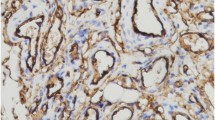Summary
The relationship between Bcl-2, Bax, Fas, caspase-3 and development of hemangioma and the molecular mechanism was investigated. By using immunohistochemical S-P method, proliferating cell nuclear antigen was detected. According to the classification of Mulliken in combination with PCNA expression, 27 cases were identified as proliferating hemangioma and 22 cases as involutive hemangioma. Five normal skin tissues around the tumor tissue served as controls. By using immunohistochemical technique, the expression of Bcl-2, Bax, Fax and Caspase-3 was detected. The cells expressing Bcl-2, Bax, Fax and cappase-3 were identified as hemangioma endothelia by immunohistochemical staining of VIII factor. The average absorbance (A) and average positive area rate of Bcl-2, Bax, Fas and caspase-3 expression were measured by using HPIAS-2000 imaging analysis system. The results showed that the expression of Bcl-2 in the endothelia of proliferating hemangioma was significantly higher that in involutive degenerative hemangioma endothelia and vascular endothelia of normal skin tissue (P<0.01). The expression of Bax, Fas and Caspase-3 in the endothelia of involutive hemangioma was obviously higher than in the endothelia of proliferating hemangioma and normal skin tissue (P<0.01). The expression of BAx and Fas in endothelia of proliferating hemangioma was higher than in those of normal skin tissue (P<0.05). It was suggested that Bcl-2, Bax, Fas and caspase-3 might be involved in the development and involution of hemangioma. Bcl-2 could promote the growth of hemangioma by inhibiting apoptosis of endothelia. Bax, Fas and caspase-3 promote the switch of hemangioma from proliferation to involution by inducing the apoptosis of hemangioma endothelia.
Similar content being viewed by others
References
Kluck R M, Bossy-Wetzel E, Green D R et al. The release of cytochrome e from mitochondria: a primary site for Bcl-2 regulation of apoptosis. Science, 1997, 275(5303):1132–1136
Chang J, Most D, Bresnick B et al. Proliferative hemangiomas: analysis of cytokine gene expression and angiogenesis. Plast Reconstr Surg, 1999,103(1):1–9
Liu Y, Zhang D, Wang R M et al. Expression of estrogen receptor and several angiogenesis factors in hemangioma and vascular malformation. Chin J Anatomy (Chinese), 2002,25(4):354–359
Hong L, Wang Y M, Wang Y et al. Apoptosis accompanying involution of infantile hemangioma. Chin J Pediatr Surg, 2002,23(3):199–201
Mulliken J B, Glowacki J. Hemangiomas and vascular malformations in infants and children: a classification based on endothelial characteristics. Plast Reconstr Surg, 1982,69(3):412–422
Wolter K G, Hsu Y T, Smith C L et al. Movement of Bax from the cytosol to mitochondria during apoptosis. J Cell Biol, 1997,139:1281–1292
13 Peng L M, Wang Z L. Basis and Clinic of Apoptosis. Beijing: People’s Medical Publishing House, 2000, 125–126
Author information
Authors and Affiliations
Additional information
YANG Hong, born in 1971, Associate Professor
This project was supported by a grant from the National Natural Science Foundation of China (No. 30500224).
Rights and permissions
About this article
Cite this article
Yang, H., Deng, C., Shen, S. et al. Expression and significance of Bcl-2, Bax, Fas and caspace-3 in different phases of human hemangioma. J. Huazhong Univ. Sc. Technol. 26, 402–404 (2006). https://doi.org/10.1007/s11596-006-0405-y
Received:
Issue Date:
DOI: https://doi.org/10.1007/s11596-006-0405-y




